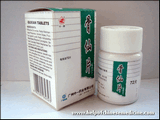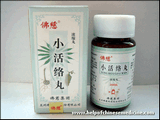If the joints are very painful and symptoms become worse in the winter, then the blockage is probably cause by wind/damp. When is the cause of arthritis, there is swelling and the heat in the joints.
Shenyi Center of Chinese medicine has a large variety of Chinese medicine for rheumatism/arthritis click here
- Chinese Medicine for cardiovascular diseases and heart
- Chinese Medicine for gastro-intestinal disorders (poor appetite, indigestion, gastritis, diarrhea)
- Chinese Medicine for men (prostatitis, impotence etc.)
- Chinese Medicine for women (gynecological conditions, pre-menstrual syndrome, infertility)
- Chinese Medicine for liver syndromes (fatty liver, hepatitis)
- Chinese Medicine skin diseases (swelling, eczema, psoriasis)
- Chinese Medicine for asthma, bronchitis, chronic coughs
- Chinese Medicine for rheumatism, arthritis, osteoarthritis
- Chinese Medicine for hypertension
- Chinese Medicine for allergies
- Chinese Medicine for common cold and flu, sore throat
- Chinese Medicine for pain relieve
- Chinese Medicine for fatigue syndrome
- Chinese Medicine for weight loss
Chinese herbal medicine Guxian pian is effective for diseases due to hyperosteogeny.
Dosage: 4-6 tablets per time, 3 times per day
Manufacturer: Guangzhou Zhongyi
Read more...
Chinese treatments are very effective for treating problems like paralysis, arthritis, and stroke. These problems are created due to blockage in the channels that restrict the movement of blood and Qi. When the channels are blocked, passage of nutrients to the essential organs is also blocked. As a result, numbness is created in various muscles and stiffness is caused. Restriction of Qi flow in the body causes pain and limits the physical movement. When the blocks are cleared, the Qi flows easily and the increased blood flow will relieve the pain and stiffness.
Dosage: 6 pills each time, 1-2 times per day, contains 200 pills
Manufacturer: Lanzhou Foci
Read more...
Duhuo jisheng tang for treating osteoarthritis of the knee: a prospective clinical observation.
Lai JN, Chen HJ, Chen CC, Lin JH, Hwang JS, Wang JD.
Department of Obstetrics and Gynecology, Taipei City Hospital, Yangming Branch, Taipei, Taiwan.
BACKGROUND: Little scientific evidence supports the efficacy of herbal medicines in the treatment of degenerative arthritis of the knee. The purpose of this study is to evaluate both the efficacy and safety of a finished Chinese herbal preparation duhuo jisheng tang (DJT) in reducing symptoms of degenerative osteoarthritis of the knee. METHODS: A prospective follow-up study was carried out in two hospitals in Taipei between April and October 2005. Sixty-eight osteoarthritis patients, with symptoms diagnosed by radiologists, received DJT at a rate of 2.5 g, twice daily for four weeks. Baseline scores were measured on the Western Ontario and McMaster Universities Osteoarthritis (WOMAC) index, followed by further measures at the end of weeks 1, 2 and 4. The World Health Organization Quality of Life (WHOQOL) assessment was undertaken as a secondary outcome, with pattern identification questionnaires being adopted. Regression models were constructed to explore the score differences between the baseline and at weeks 2 and 4 by various determinants including age, gender, body mass index (BMI), severity at baseline, use of rescue medication, aversion to cold and flaccidity of the lower back and knees. RESULTS: Among the 68 participants, there were statistically significant reductions in the WOMAC index scores for pain, stiffness and physical functioning in the second and fourth weeks, with effects first appearing during week 2. By week 4, the mean WOMAC index scores had fallen from 22.2 (+/- 19.2) to 16.1 (+/- 16.2) for pain, from 28.1 (+/- 24.9) to 18.5 (+/- 20.3) for stiffness, and from 22.6 (+/- 18.0) to 18.2 (+/- 17.8) for physical functioning, while the global score for pain under the visual analogue scale (VAS) was reduced from 38.7 (+/- 21.5) to 27.8 (+/- 19.8). CONCLUSION: In the treatment of degenerative osteoarthritis of the knee, a 4-week therapy with the Chinese herbal preparation DJT reduced pain and stiffness and improved physical functioning, but it was less effective in treating flaccidity and aversion to cold.
Use of herbal preparations in the treatment of oxidant-mediated inflammatory disorders.
Kaplan M, Mutlu EA, Benson M, Fields JZ, Banan A, Keshavarzian A.
Rush University Medical Center, Department of Internal Medicine, Section of Gastroenterology and Nutrition, 1725 West Harrison Street, Suite 206, Chicago, IL 60612-3824, United States.
Complementary and alternative medicine (CAM) use has increased in popularity in recent years and herbal therapy alone is now a billion dollar market. For centuries herbs have been used as food and for medicinal purposes. Various herbs have been identified as possessing anti-inflammatory and antioxidative properties, and they are currently being used to treat inflammatory disorders as well as those caused by reactive oxygen species (ROS). Asthma, Alzheimer's disease, inflammatory bowel disease (IBD), rheumatoid arthritis (RA), and atherogenesis are all disorders where inflammation and ROS are involved in their pathogenesis. This review examines the pathogenesis of the above mentioned ROS-mediated inflammatory disorders, as well as discusses the antioxidant and anti-inflammatory mechanisms of various herbs and the clinical trials where herbs have been used to treat these disorders.
Treatment with total alkaloids from Radix Linderae reduces inflammation and joint destruction in type II collagen-induced model for rheumatoid arthritis.
Wang C, Dai Y, Yang J, Chou G, Wang C, Wang Z.
Department of Pharmacology of Chinese Materia Medica, China Pharmaceutical University, 1 Shennong Road, Nanjing 210038, China.
Radix Linderae, the dry roots of Lindera aggregata (Sims) Kosterm., is frequently used in traditional Chinese medicine. It contains alkaloids, volatile oils and sesquiterpene esters. In the present study, we investigated the therapeutic potential and underlying mechanisms of the total alkaloids from Radix Linderae (TARL) on collagen II (CII)-induced arthritis (CIA) in mice. TARL (50, 100 and 200mg/kg), orally administered on the same day of an antigen challenge for 20 consecutive days, alleviated disease severity in a dose-dependent manner but did not significantly affect body weights. The TARL treatment reduced the serum level of anti-CII IgG and suppressed the delayed type hypersensitivity evaluated by its effect against CII-induced ear swelling. TARL also protected joint destruction based on the evidence of reducing the histopathological scores. Furthermore, TARL suppressed CII- and concanavalin A-stimulated lymphocyte proliferation in popliteal lymph nodes, where are close to the affected joints in CIA. These data suggest that TARL is a potential therapeutic agent for rheumatoid arthritis that suppresses inflammation and protects joints from destruction.
Suppressive effects of Stephania tetrandra on the neutrophil function in patients with rheumatoid arthritis.
Sekiya N, Shimada Y, Niizawa A, Kogure T, Mantani N, Sakai S, Hikiami H, Terasawa K.
Department of Japanese Oriental Medicine, Faculty of Medicine, Toyama Medical and Pharmaceutical University, Sugitani 2630, Toyama 930-0194, Japan.
Crude preparations of Stephania tetrandra (ST), a traditional herbal medicine, have been used safely for arthritis and silicosis in China. The concentration of granulocyte elastase - alpha 1 protease inhibitor complex in plasma is enhanced in inflammatory processes, e.g. in septicaemia and rheumatoid arthritis (RA), being an expression of granulocyte activation during inflammatory response. It has previously been reported that ST showed beneficial and immunomodulatory effects in the treatment of relatively mild RA. After the administration of ST for 12 weeks, the proportion of granulocytes and the granulocyte count in peripheral blood decreased significantly. The lipid peroxide and human granulocyte elastase levels of stored plasma declined significantly. Furthermore, both the leukocyte/elastase ratio and granulocyte/elastase ratio increased significantly.The findings of this study suggest that the suppressive effect of ST administration on excessive granulocyte activation resulted in the improvement of inflammation with rheumatoid arthritis.
Clinical observation on treatment of rheumatoid arthritis by combined therapy with methotrexate, sulfasalazine and Chinese herbal medicine
Lu SJ, Shao J, Li XR.
Victory Hospital of Victory Petroleum Administration, Shandong 257055.
OBJECTIVE: To observe the effect of Fengshi No. 1 (FS1) in treating patients with active stage of rheumatoid arthritis (RA). METHODS: Patients with RA were randomly divided into two groups, the 40 patients in the treated group were treated with combined therapy of methotrexate (MTX), sulfasalazine (SSZ) and FS1, and the 20 in the control groups were treated with MTX and SSZ alone. RESULTS: In the treated group, the total effective rate was 97.5%, the clinical controlled and markedly effective rate 95.0% and the occurrence rate of side-toxic reaction 10.0%, as compared with those in the control group, 60.0%, 20.0% and 45.0% respectively, the difference was significant (chi 2 = 11.91, 32.23 and 7.67 respectively, all P < 0.01). The effect in the treated group was superior to that in the control group in abating joint swelling and pain, improving function of joint, reducing immune indices and ameliorating iconographic features (P < 0.01 or P < 0.05). CONCLUSION: FS1 not only has the effects of anti-inflammation, analgesis, regulating immune reaction, but also could retard the occurring of bone destruction, reduce the toxic-side effects of MTX and SSZ.
Study on therapeutic mechanism of anti-rheumatism action of herba siegesbeckiae
Qian R, Zhang C, Fu H.
Department of Integrated Traditional Chinese and Western Medicine, Bejing Medical University, Beijing (100083).
OBJECTIVE: To explore the mechanism of anti-rheumatism action of the active fraction of Herba Siegesbeckiae (AFHS). METHODS: Adjuvant arthritis model of rat was made to observe the effect of AFHS on lymphocyte proliferation, interluekin-1 (IL-1) and IL-2 activity, pathologic section of ankle joint, and analgesic effect of AFHS in model rat. RESULTS: AFHS could reduce the inflammatory pathologic response of ankle joint, it functions well as analgesics, the analgesic rate being 65%, AFHS could also improve T-lymphocyte proliferation, improve IL-2 activity and inhibit IL-1 activity, as compared with the control group, the difference was significant (P < 0.01). CONCLUSION: Through regulating the immune function of organism, AFHS could improve the local pathologic response so as to antagonise against rheumatism, therefore, it is a good anti-rheumatism herbal medicine.
Herbal therapy for treating rheumatoid arthritis.
Little C, Parsons T.
Institute of Health & Community Studies, Bournemouth University, Bournemouth House, Bournemouth University, 17 Christchurch Road, Bournemouth, Dorset, UK, BH1 3LG.
BACKGROUND: The increasing popularity of the use of complementary and alternative interventions or treatments appears to be particularly evident amongst people with chronic disease. In the treatment of rheumatoid arthritis, one therapy that has been identified as having potential benefit, is herbal medicine (phytotherapy). OBJECTIVES: To assess the effectiveness of herbal therapies in the treatment of rheumatoid arthritis. SEARCH STRATEGY: We developed a search strategy using terms to include all forms of arthritis combined with herbal medicine. We searched the following electronic databases from 1966 to 2000: MEDLINE, EMBASE, CISCOM, AMED, CINAHL, Cochrane Controlled Trials Register (CCTR), Cochrane Musculoskeletal specialized register, Dissertation Abstracts, BIDS ISI and the Cochrane Complementary Medicine Fields Specialized Register. This was supplemented by searching the reference lists from retrieved trials. SELECTION CRITERIA: All randomized trials of herbal interventions in rheumatoid arthritis, compared to placebo. Two reviewers independently read and selected each potential study according to the criteria published in an a priori protocol. Papers of any language were included. DATA COLLECTION AND ANALYSIS: Data were extracted independently by the same two reviewers and an assessment of methodological quality was conducted. MAIN RESULTS: Eleven studies met the inclusion criteria. Seven of the studies compared gamma-linolenic acid (GLA) to placebo although three of these were not suitable for data pooling. The remaining studies considered four different herbal interventions and were assessed individually. All of the GLA studies found some improvement in clinical outcomes but methodology and study quality was variable, making it difficult to draw conclusive results. However, the better quality studies suggest potential relief of pain, morning stiffness and joint tenderness. With the exception of one intervention (Tripterygium wilfordii hook F), no serious side effects were reported. REVIEWER'S CONCLUSIONS: There appears to be some potential benefit for the use of GLA in rheumatoid arthritis although further studies are required to establish optimum dosage and duration of treatment. The single studies are inconclusive.



